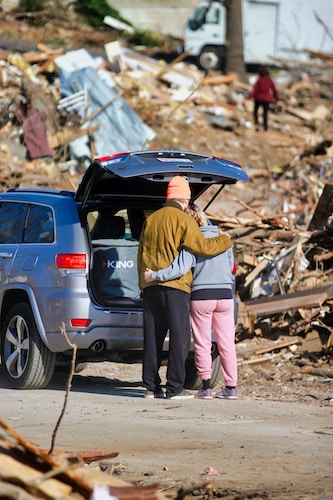
Be Prepared, Stay Safe: How to Prepare for an Emergency
In an unpredictable world, being prepared for emergencies is crucial to ensure the safety and well-being of yourself and your loved ones. By taking proactive measures and having a well-thought-out plan, you can mitigate risks, minimize potential harm, and navigate through emergencies with confidence. This comprehensive guide will provide you with essential tips and strategies on how to prepare for an emergency, empowering you to secure your safety and achieve peace of mind.
Assemble an Emergency Preparedness Kit: Building Your Lifeline: Assembling an Emergency Preparedness Kit
The first step in emergency preparedness is to assemble an emergency preparedness kit. This kit serves as your lifeline during emergencies, providing essential supplies and tools to sustain you until help arrives. Include items such as non-perishable food, drinking water, a first aid kit, flashlights, batteries, a portable radio, a multi-purpose tool, extra clothing and blankets, medications, and important documents in a sturdy and easily accessible container. Regularly check and refresh the supplies in your kit to ensure they are up to date and in good condition. By assembling an emergency preparedness kit, you fortify your ability to respond effectively during emergencies.
Create an Emergency Communication Plan: Connected and Informed: Creating an Emergency Communication Plan
During an emergency, communication becomes crucial for coordination and ensuring the safety of your family members. Create an emergency communication plan that includes contact information for each family member, designated meeting points, and an out-of-town emergency contact who can serve as a central point of communication. Ensure that every family member is aware of the plan and knows how to reach each other. Practice the plan through regular drills to familiarize everyone with the procedures. By establishing an emergency communication plan, you enhance your ability to stay connected and informed during critical situations. Consider GPS beacons or satellite forms of communication in case cell phone networks are down. A helpful guide is the “PACE” plan where you prepare Primary, Alternate, Contingency, and Emergency methods of communication to ensure continuous, redundant communications.
Know Your Evacuation Routes : Charting the Path to Safety: Knowing Your Evacuation Routes
In certain emergencies, evacuating your home may be necessary for your safety. Familiarize yourself with the evacuation routes in your area, including primary and alternate routes. Understand the local evacuation procedures and any specific instructions provided by authorities. Plan ahead by identifying designated shelters or safe locations where you can seek refuge if needed. Consider the needs of all family members, including pets or individuals with disabilities, and make necessary arrangements to ensure their safety during evacuation. By knowing your evacuation routes, you optimize your ability to navigate to safety swiftly and efficiently.
Stay Informed with Emergency Alerts: Timely Updates for Safety: Staying Informed with Emergency Alerts
During emergencies, staying informed about the evolving situation is crucial. Sign up for local emergency alert systems and notifications to receive timely updates and instructions from authorities. Install relevant mobile apps or subscribe to email alerts to stay informed even when on the go. Pay attention to weather forecasts, news reports, and official announcements to stay abreast of any developments or changes in the situation. By staying informed with emergency alerts, you can make informed decisions and take appropriate actions to protect yourself and your family.
Familiarize Yourself with Community Emergency Plans: Strength in Unity: Familiarizing Yourself with Community Emergency Plans
Understanding the emergency plans in your community is essential for effective response and cooperation during emergencies. Research and familiarize yourself with the emergency plans and protocols established by local authorities, schools, workplaces, or other relevant organizations. Identify resources available in your community, such as emergency shelters or support services. Participate in community drills or training exercises to enhance your preparedness and strengthen the overall resilience of your community. By being familiar with community emergency plans, you contribute to a more coordinated and efficient response to emergencies.
Safeguard Your Home and Property: Protecting Your Haven: Safeguarding Your Home and Property
While emergencies can be unpredictable, taking proactive measures to safeguard your home and property can minimize potential risks and damages. Install and maintain appropriate security measures such as robust locks, security cameras, and an alarm system to deter potential intruders. Secure important documents and valuables in fireproof and waterproof containers or safes. Conduct regular maintenance checks to identify and address any safety hazards, such as faulty wiring or leaky pipes. By fortifying your home and property, you create a more secure and resilient environment.
Learn Basic First Aid and Life-Saving Techniques: Lifesaving Skills: Learning Basic First Aid and Life-Saving Techniques
Being equipped with basic first aid and life-saving techniques can make a significant difference in emergencies, where immediate medical assistance may be delayed. Enroll in a first aid and CPR course to learn essential skills such as assessing injuries, performing cardiopulmonary resuscitation (CPR), and providing basic medical care. Additionally, familiarize yourself with other life-saving techniques such as the Heimlich maneuver and how to control bleeding. By acquiring these skills, you enhance your ability to provide crucial aid and potentially save lives during emergencies.
Prepare for Specific Types of Emergencies: Tailoring Your Preparedness: Preparing for Specific Types of Emergencies
Different emergencies may require specific preparations and responses. Research and understand the potential hazards in your area, such as earthquakes, floods, hurricanes, or wildfires, and prepare accordingly. For example, in earthquake-prone areas, secure heavy furniture and objects that could pose a risk of falling during tremors. In flood-prone areas, elevate valuable items and consider flood insurance. By tailoring your preparedness to specific types of emergencies, you increase your resilience and adaptability in the face of potential threats.
Practice Self-Care and Emotional Resilience: Nurturing Strength Within: Practicing Self-Care and Emotional Resilience
Coping with emergencies can be emotionally and mentally challenging. Practice self-care and emotional resilience by maintaining a healthy lifestyle, nurturing supportive relationships, and seeking professional help if needed. Develop coping mechanisms such as deep breathing exercises, mindfulness, or engaging in activities that promote relaxation and well-being. Prioritize self-care and encourage open communication with your loved ones to foster a supportive environment. By practicing self-care and emotional resilience, you enhance your overall well-being and fortify your ability to face emergencies.
Preparing for an emergency is an ongoing process that requires proactive measures, knowledge, and planning. By assembling an emergency preparedness kit, creating an emergency communication plan, knowing evacuation routes, familiarizing yourself with community emergency plans, staying informed, safeguarding your home, learning life-saving techniques, preparing for specific types of emergencies, and practicing self-care, you empower yourself to navigate emergencies with confidence and resilience. Remember, preparedness is key to ensuring your safety, protecting your loved ones, and achieving peace of mind in the face of uncertainty.



